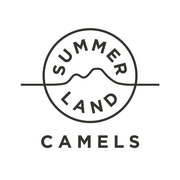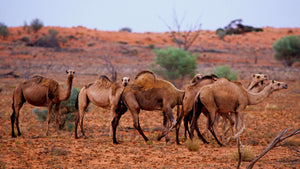Camels and Culling in Australia: A Complex Issue
Australia, with its vast and unique landscape, is home to a surprising number of feral animals, including camels. The issue of managing these wild camel populations, however, has become a contentious topic. Culling has often been used as a method to control their numbers, but this approach is fraught with debate. How do wild camels compare to other feral animals in Australia? Is culling the right answer, or are there more humane and beneficial solutions?

How Do Wild Camels Compare to Other Feral Animals in Australia?
Wild camels are just one part of Australia’s extensive feral animal problem. Approximately 500,000 feral, unmanaged camels roam the country. While this may seem like a significant number, it pales in comparison to other feral animals wreaking havoc on the environment.
- Feral Pigs: Australia is home to an estimated 27 million feral pigs, with a staggering number in Queensland alone. Feral pigs are notorious for damaging ecosystems, particularly by eating sea turtle eggs off beaches, which leads to reduced sea turtle populations. This imbalance results in a proliferation of poisonous jellyfish, as baby sea turtles typically prey on them. With over 50 times as many feral pigs as camels in Australia, why is the focus not on controlling their numbers instead of camels?
- Feral Cats: The feral cat population is estimated to be over 68 million in Queensland alone—136 times more than the camel population. Feral cats are particularly destructive to native wildlife, with estimates suggesting they kill 68 to 140 million native animals every week. This makes them a far more pressing ecological concern than camels, yet efforts to control feral cats are less pronounced.
- Feral Horses, Donkeys, and Cattle: Australia also grapples with approximately 2.4 million feral horses, 2.3 million feral donkeys, and around 1.5 million feral cattle. These animals, like camels, contribute to environmental degradation but on a far larger scale.
- Feral Goats: The population of feral goats in Australia is over 20 million. Interestingly, goats are now being semi-managed for their meat, which is exported overseas. This raises the question: why aren’t camels being similarly managed instead of being culled?
Culling: A Headline-Grabbing Solution
Culling is often the go-to method for controlling camel populations, but it is far from a perfect solution. Shooting camels from helicopters, which is how culls are typically carried out, often results in slow and painful deaths for the animals. Moreover, culling is expensive, and the camel carcasses are often left to rot, wasting valuable resources like meat and hide.
Instead of culling, a more humane and commercially beneficial approach could be explored. Providing water stations outside communities, where camels are likely to congregate during droughts, could prevent them from entering settlements in search of water. This simple solution would benefit not just camels but all animals struggling in Australia's increasingly harsh climate.
Profiteering and the Politics of Culling
Culling camels often becomes politicized, with various stakeholders seeking exorbitant funding for the task. Governments get involved, subcontracting expensive aerial shooters, while Indigenous communities, who rely on camels for income, are left out of the conversation. Many Indigenous communities muster wild camels and sell them into meat markets, particularly in the Middle East and North Africa. Instead of culling, why not invest in these communities and the camel industry to better manage and profit from this valuable resource?
Instead of culling camels, Australia should look at how to support Indigenous communities and commercial camel dairy farmers to better manage, benefit, and profit from this invaluable resource.
Why Do Wild Camels Seek Water in Settlements?
Australia's severe droughts and frequent bushfires have had a profound impact on all animals, both native and introduced. However, camels, due to their ability to survive longer without water, are often the last animals to seek water in settlements. When they do, they can cause damage to infrastructure as they search for water, breaking pipes, taps, and hoses in the process.
Other animals like cattle, horses, and donkeys are more fearful of humans and avoid entering communities, but camels are intelligent and weigh the risk against the reward of accessing water. This behaviour has led to camels being unfairly labelled as pests. A more effective solution than culling would be to provide water troughs outside of communities to satisfy the camels' needs and prevent damage.

Photo by Mark Vegera
Why Are Camels Seen as Pests?
The perception of camels as pests in Australia has its roots in history. European settlers, unfamiliar with camels, viewed them as competition to their more familiar livestock. Moreover, cameleers—many of whom were dark-skinned immigrants from regions such as Afghanistan, Africa, and the Middle East—were often discriminated against, which extended to their animals. These negative perceptions have persisted for generations, despite camels being better suited to Australia’s environment than most other livestock.
What Makes Australia's Camels Unique?
Australia’s wild camels have become a genetic treasure trove. With their origins tracing back to the 12,000 to 20,000 camels imported from various countries between 1854 and 1915, Australia now boasts one of the most diverse and disease-free camel populations in the world. In contrast, many camel populations globally have declined, making Australia's wild camels an invaluable resource.
Camels and Climate Change
In a time of climate change, camels could play a crucial role in Australia's future. They produce less methane than cattle and sheep, contribute minimally to total livestock emissions, and are well-suited to the increasingly hot and dry conditions expected in Australia. Furthermore, camels produce some of the world’s finest wool, leather, and healthy meat and milk, making them a potentially valuable asset in a changing climate.
Culling camels might grab headlines, but it is far from a comprehensive or humane solution. Australia should reconsider its approach to managing wild camels, focusing on providing water, supporting Indigenous communities, and investing in the growing camel industry. These animals, far from being pests, are uniquely suited to Australia's environment and have the potential to be a vital part of its ecological and economic future.

What Summer Land Camels is Doing
At Summer Land Camels, we are committed to turning this complex issue into an opportunity. Rather than viewing wild camels as pests, we believe they are an underutilised resource with immense potential. We are working to create a sustainable industry around the Australian wild camel, transforming what was once seen as a problem into a solution. By partnering with Indigenous communities, farmers, and other stakeholders, we are actively helping to manage wild camel populations in a way that is humane and economically beneficial.
Our farm, located just one hour from Brisbane, demonstrates the potential of the camel industry through our production of high-quality camel milk, skincare products, and a range of sustainable goods derived from camel by-products. Through these initiatives, we aim to reduce the need for culling by fostering demand for camel products both domestically and internationally, helping to build a future where camels contribute to Australia’s economy and environment rather than being culled.

How You Can Help
You can be part of the solution by supporting Summer Land Camels in our efforts. By visiting our farm, purchasing our products, or spreading awareness about this issue, you directly contribute to a better future for these incredible animals. Take part in a camel encounter or farm tour to learn more about the history and importance of camels in Australia, meet our gentle herd, and even experience a camel ride!
If you’re looking for high-quality, sustainable products, explore our range of camel dairy products, including fresh milk, camel milk powder, vodka and our luxurious skincare line made with camel milk. By purchasing from Summer Land Camels, you’re supporting not just a local business but a larger mission to create an industry that provides an alternative to culling. Every purchase helps us continue our work, and together, we can make a meaningful difference.

